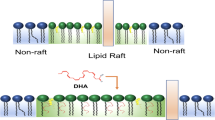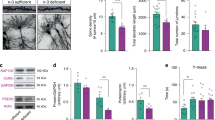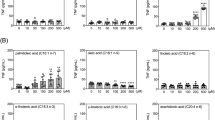Abstract
Polyunsaturated fatty acids (PUFAs) display immunomodulatory properties in the brain, n-3 PUFAs being able to reduce inflammation whereas n-6 PUFAs are more pro-inflammatory. It has been extensively demonstrated that exposure to a peripheral immune challenge leads to the production and release of inflammatory mediators in the brain in association with cognitive deficits. The question arises whether n-3 PUFA supplementation could downregulate the brain inflammatory response and subsequent cognitive alterations. In this study, we used a genetically modified mouse line carrying the fat-1 gene from the roundworm Caenorhabditis elegans, encoding an n-3 PUFA desaturase that catalyzes conversion of n-6 into n-3 PUFA. Consequently, these mice display endogenously elevated n-3 PUFA tissue contents. Fat-1 mice or wild-type (WT) littermates were injected peripherally with lipopolysaccharide (LPS), a bacterial endotoxin, to induce an inflammatory episode. Our results showed that LPS altered differently the phenotype of microglia and the expression of cytokines and chemokines in Fat-1 and WT mice. In Fat-1 mice, pro-inflammatory factors synthesis was lowered compared with WT mice, whereas anti-inflammatory mechanisms were favored 24 h after LPS treatment. Moreover, LPS injection impaired spatial memory in WT mice, whereas interestingly, the Fat-1 mice showed normal cognitive performances. All together, these data suggest that the central n-3 PUFA increase observed in Fat-1 mice modulated the brain innate immune system activity, leading to the protection of animals against LPS-induced pro-inflammatory cytokine production and subsequent spatial memory alteration.
Similar content being viewed by others
Log in or create a free account to read this content
Gain free access to this article, as well as selected content from this journal and more on nature.com
or
References
Arai K, Matsuki N, Ikegaya Y, Nishiyama N (2001). Deterioration of spatial learning performances in lipopolysaccharide-treated mice. Jpn J Pharmacol 87: 195–201.
Aubert A, Vega C, Dantzer R, Goodall G (1995). Pyrogens specifically disrupt the acquisition of a task involving cognitive processing in the rat. Brain Behav Immun 9: 129–148.
Bagga D, Wang L, Farias-Eisner R, Glaspy JA, Reddy ST (2003). Differential effects of prostaglandin derived from omega-6 and omega-3 polyunsaturated fatty acids on COX-2 expression and IL-6 secretion. Proc Natl Acad Sci USA 100: 1751–1756.
Baitsch D, Bock HH, Engel T, Telgmann R, Muller-Tidow C, Varga G et al (2011). Apolipoprotein E induces antiinflammatory phenotype in macrophages. Arterioscler Thromb Vasc Biol 31: 1160–1168.
Bhattacharjee A, Shukla M, Yakubenko VP, Mulya A, Kundu S, Cathcart MK (2013). IL-4 and IL-13 employ discrete signaling pathways for target gene expression in alternatively activated monocytes/macrophages. Free Radic Biol Med 54: 1–16.
Biber K, Neumann H, Inoue K, Boddeke HW (2007). Neuronal 'On' and 'Off' signals control microglia. Trends Neurosci 30: 596–602.
Boudrault C, Bazinet RP, Kang JX, Ma DW (2010). Cyclooxygenase-2 and n-6 PUFA are lower and DHA is higher in the cortex of fat-1 mice. Neurochem Int 56: 585–589.
Brenneis C, Coste O, Altenrath K, Angioni C, Schmidt H, Schuh CD et al (2011). Anti-inflammatory role of microsomal prostaglandin E synthase-1 in a model of neuroinflammation. J Biol Chem 286: 2331–2342.
Calder PC (2001). Polyunsaturated fatty acids, inflammation, and immunity. Lipids 36: 1007–1024.
Cardona AE, Pioro EP, Sasse ME, Kostenko V, Cardona SM, Dijkstra IM et al (2006). Control of microglial neurotoxicity by the fractalkine receptor. Nat Neurosci 9: 917–924.
Chhor V, Le Charpentier T, Lebon S, Ore MV, Celador IL, Josserand J et al (2013). Characterization of phenotype markers and neuronotoxic potential of polarised primary microglia in vitro. Brain Behav Immun 32: 70–85.
Cho SH, Sun B, Zhou Y, Kauppinen TM, Halabisky B, Wes P et al (2011). CX3CR1 protein signaling modulates microglial activation and protects against plaque-independent cognitive deficits in a mouse model of Alzheimer disease. J Biol Chem 286: 32713–32722.
Cunningham C, Sanderson DJ (2008). Malaise in the water maze: untangling the effects of LPS and IL-1beta on learning and memory. Brain Behav Immun 22: 1117–1127.
Dantzer R, O'Connor JC, Freund GG, Johnson RW, Kelley KW (2008). From inflammation to sickness and depression: when the immune system subjugates the brain. Nat Rev Neurosci 9: 46–56.
Farooqui AA, Horrocks LA, Farooqui T (2007). Modulation of inflammation in brain: a matter of fat. J Neurochem 101: 577–599.
Frank MG, Wieseler-Frank JL, Watkins LR, Maier SF (2006). Rapid isolation of highly enriched and quiescent microglia from adult rat hippocampus: immunophenotypic and functional characteristics. J Neurosci Methods 151: 121–130.
Garden GA, Moller T (2006). Microglia biology in health and disease. J Neuroimmune Pharmacol 1: 127–137.
Gibertini M, Newton C, Friedman H, Klein TW (1995). Spatial learning impairment in mice infected with Legionella pneumophila or administered exogenous interleukin-1-beta. Brain Behav Immun 9: 113–128.
Heerwagen MJ, Stewart MS, de la Houssaye BA, Janssen RC, Friedman JE (2013). Transgenic increase in N-3/n-6 Fatty Acid ratio reduces maternal obesity-associated inflammation and limits adverse developmental programming in mice. PLoS One 8: e67791.
Henderson RJ, Bell JG, Park MT (1996). Polyunsaturated fatty acid composition of the salmon (Salmo salar L.) pineal organ: modification by diet and effect on prostaglandin production. Biochim Biophys Acta 1299: 289–298.
Henry CJ, Huang Y, Wynne AM, Godbout JP (2009). Peripheral lipopolysaccharide (LPS) challenge promotes microglial hyperactivity in aged mice that is associated with exaggerated induction of both pro-inflammatory IL-1beta and anti-inflammatory IL-10 cytokines. Brain Behav Immun 23: 309–317.
Henry CJ, Huang Y, Wynne A, Hanke M, Himler J, Bailey MT et al (2008). Minocycline attenuates lipopolysaccharide (LPS)-induced neuroinflammation, sickness behavior, and anhedonia. J Neuroinflammation 5: 15.
Hirai T, Uchida K, Nakajima H, Guerrero AR, Takeura N, Watanabe S et al (2013). The prevalence and phenotype of activated microglia/macrophages within the spinal cord of the hyperostotic mouse (twy/twy) changes in response to chronic progressive spinal cord compression: implications for human cervical compressive myelopathy. PLoS One 8: e64528.
Kang JX (2007). Fat-1 transgenic mice: a new model for omega-3 research. Prostaglandins Leukot Essent Fatty Acids 77: 263–267.
Kang JX, Wang J, Wu L, Kang ZB (2004). Transgenic mice: fat-1 mice convert n-6 to n-3 fatty acids. Nature 427: 504.
Kawahara K, Suenobu M, Yoshida A, Koga K, Hyodo A, Ohtsuka H et al (2012). Intracerebral microinjection of interleukin-4/interleukin-13 reduces beta-amyloid accumulation in the ipsilateral side and improves cognitive deficits in young amyloid precursor protein 23 mice. Neuroscience 207: 243–260.
Kelly L, Grehan B, Chiesa AD, O'Mara SM, Downer E, Sahyoun G et al (2011). The polyunsaturated fatty acids, EPA and DPA exert a protective effect in the hippocampus of the aged rat. Neurobiol Aging 32: e2311–e2315.
Labrousse VF, Costes L, Aubert A, Darnaudery M, Ferreira G, Amedee T et al (2009). Impaired interleukin-1beta and c-Fos expression in the hippocampus is associated with a spatial memory deficit in P2X(7) receptor-deficient mice. PLoS One 4: e6006.
Labrousse VF, Nadjar A, Joffre C, Costes L, Aubert A, Gregoire S et al (2012). Short-term long chain omega3 diet protects from neuroinflammatory processes and memory impairment in aged mice. PLoS One 7: e36861.
Lafourcade M, Larrieu T, Mato S, Duffaud A, Sepers M, Matias I et al (2011). Nutritional omega-3 deficiency abolishes endocannabinoid-mediated neuronal functions. Nat Neurosci 14: 345–350.
Larrieu T, Madore C, Joffre C, Laye S (2012). Nutritional n-3 polyunsaturated fatty acids deficiency alters cannabinoid receptor signaling pathway in the brain and associated anxiety-like behavior in mice. J Physiol Biochem 68: 671–681.
Laye S (2010). Polyunsaturated fatty acids, neuroinflammation and well being. Prostaglandins Leukot Essent Fatty Acids 82: 295–303.
Laye S, Parnet P, Goujon E, Dantzer R (1994). Peripheral administration of lipopolysaccharide induces the expression of cytokine transcripts in the brain and pituitary of mice. Brain Res Mol Brain Res 27: 157–162.
Madore C, Joffre C, Delpech JC, De Smedt-Peyrusse V, Aubert A, Coste L et al (2013). Early morphofunctional plasticity of microglia in response to acute lipopolysaccharide. Brain Behav Immun 34: 151–158.
Mantovani A, Sica A, Locati M (2005). Macrophage polarization comes of age. Immunity 23: 344–346.
Matsumura K, Cao C, Ozaki M, Morii H, Nakadate K, Watanabe Y (1998). Brain endothelial cells express cyclooxygenase-2 during lipopolysaccharide-induced fever: light and electron microscopic immunocytochemical studies. J Neurosci 18: 6279–6289.
Merrill JE, Zimmerman RP (1991). Natural and induced cytotoxicity of oligodendrocytes by microglia is inhibitable by TGF beta. Glia 4: 327–331.
Mingam R, Moranis A, Bluthe RM, De Smedt-Peyrusse V, Kelley KW, Guesnet P et al (2008). Uncoupling of interleukin-6 from its signalling pathway by dietary n-3-polyunsaturated fatty acid deprivation alters sickness behaviour in mice. Eur J Neurosci 28: 1877–1886.
Moranis A, Delpech JC, De Smedt-Peyrusse V, Aubert A, Guesnet P, Lavialle M et al (2012). Long term adequate n-3 polyunsaturated fatty acid diet protects from depressive-like behavior but not from working memory disruption and brain cytokine expression in aged mice. Brain Behav Immun 26: 721–731.
Nadjar A, Sauvant J, Combe C, Parnet P, Konsman JP (2010). Brain cyclooxygenase-2 mediates interleukin-1-induced cellular activation in preoptic and arcuate hypothalamus, but not sickness symptoms. Neurobiol Dis 39: 393–401.
Nair A, Hunzeker J, Bonneau RH (2007). Modulation of microglia and CD8(+) T cell activation during the development of stress-induced herpes simplex virus type-1 encephalitis. Brain Behav Immun 21: 791–806.
O'Connor JC, Lawson MA, Andre C, Moreau M, Lestage J, Castanon N et al (2009). Lipopolysaccharide-induced depressive-like behavior is mediated by indoleamine 2,3-dioxygenase activation in mice. Mol Psychiatry 14: 511–522.
Orr SK, Tong JY, Kang JX, Ma DW, Bazinet RP (2010). The fat-1 mouse has brain docosahexaenoic acid levels achievable through fish oil feeding. Neurochem Res 35: 811–819.
Orr SK, Palumbo S, Bosetti F, Mount HT, Kang JX, Greenwood CE et al (2013). Unesterified docosahexaenoic acid is protective in neuroinflammation. J Neurochem 127: 378–393.
Pugh CR, Kumagawa K, Fleshner M, Watkins LR, Maier SF, Rudy JW (1998). Selective effects of peripheral lipopolysaccharide administration on contextual and auditory-cue fear conditioning. Brain Behav Immun 12: 212–229.
Quan N, Whiteside M, Herkenham M (1998). Cyclooxygenase 2 mRNA expression in rat brain after peripheral injection of lipopolysaccharide. Brain Res 802: 189–197.
Ransohoff RM (2009). Chemokines and chemokine receptors: standing at the crossroads of immunobiology and neurobiology. Immunity 31: 711–721.
Ransohoff RM, Cardona AE (2010). The myeloid cells of the central nervous system parenchyma. Nature 468: 253–262.
Remington LT, Babcock AA, Zehntner SP, Owens T (2007). Microglial recruitment, activation, and proliferation in response to primary demyelination. Am J Pathol 170: 1713–1724.
Rogers JT, Morganti JM, Bachstetter AD, Hudson CE, Peters MM, Grimmig BA et al (2011). CX3CR1 deficiency leads to impairment of hippocampal cognitive function and synaptic plasticity. J Neurosci 31: 16241–16250.
Serhan CN, Chiang N, Van Dyke TE (2008). Resolving inflammation: dual anti-inflammatory and pro-resolution lipid mediators. Nat Rev Immunol 8: 349–361.
Serhan CN, Hong S, Gronert K, Colgan SP, Devchand PR, Mirick G et al (2002). Resolvins: a family of bioactive products of omega-3 fatty acid transformation circuits initiated by aspirin treatment that counter proinflammation signals. J Exp Med 196: 1025–1037.
Simopoulos AP (2001). Evolutionary aspects of diet and essential fatty acids. World Rev Nutr Diet 88: 18–27.
Song C, Horrobin D (2004). Omega-3 fatty acid ethyl-eicosapentaenoate, but not soybean oil, attenuates memory impairment induced by central IL-1beta administration. J Lipid Res 45: 1112–1121.
Sparkman NL, Kohman RA, Scott VJ, Boehm GW (2005). Bacterial endotoxin-induced behavioral alterations in two variations of the Morris water maze. Physiol Behav 86: 244–251.
Tanaka S, Ide M, Shibutani T, Ohtaki H, Numazawa S, Shioda S et al (2006). Lipopolysaccharide-induced microglial activation induces learning and memory deficits without neuronal cell death in rats. J Neurosci Res 83: 557–566.
Thomson LM, Sutherland RJ (2005). Systemic administration of lipopolysaccharide and interleukin-1beta have different effects on memory consolidation. Brain Res Bull 67: 24–29.
Wohleb ES, Fenn AM, Pacenta AM, Powell ND, Sheridan JF, Godbout JP (2012). Peripheral innate immune challenge exaggerated microglia activation, increased the number of inflammatory CNS macrophages, and prolonged social withdrawal in socially defeated mice. Psychoneuroendocrinology 37: 1491–1505.
Wynne AM, Henry CJ, Huang Y, Cleland A, Godbout JP (2010). Protracted downregulation of CX3CR1 on microglia of aged mice after lipopolysaccharide challenge. Brain Behav Immun 24: 1190–1201.
Yirmiya R, Goshen I (2011). Immune modulation of learning, memory, neural plasticity and neurogenesis. Brain Behav Immun 25: 181–213.
Acknowledgements
We thank Dr Guillaume Ferreira for helpful comments on the manuscript. We also thank Dr Guillaume Ferreira and Pr Muriel Darnaudery for helping with behavioral experiments. We acknowledge the technical support from V. Pitard and S. Gonzalez from the cytometry platform at the Structure Federative de Recherche TransBioMed at the University of Bordeaux Segalen. We thank J.C. Helbling and C. Tridon for transgenic mice genotyping. We also thank P. Birac, C. Tridon, and M. Cadet for taking care of the mice. This research was financially supported by INRA, ANR, and Fondation pour la Recherche Medicale (FRM). JCD is the recipient of a postdoctoral fellowship from the Région Aquitaine. This project was also supported by the grant LABEX BRAIN ANR-10-LABX-43.
Author information
Authors and Affiliations
Corresponding author
Rights and permissions
About this article
Cite this article
Delpech, JC., Madore, C., Joffre, C. et al. Transgenic Increase in n-3/n-6 Fatty Acid Ratio Protects Against Cognitive Deficits Induced by an Immune Challenge through Decrease of Neuroinflammation. Neuropsychopharmacol 40, 525–536 (2015). https://doi.org/10.1038/npp.2014.196
Received:
Revised:
Accepted:
Published:
Issue date:
DOI: https://doi.org/10.1038/npp.2014.196
This article is cited by
-
Fish oil omega-3 Fatty Acids Alleviate Postoperative delirium-like Behavior in aged mice by Attenuating Neuroinflammation and Oxidative Stress
Neurochemical Research (2024)
-
Mice prenatally exposed to valproic acid do not show autism-related disorders when fed with polyunsaturated fatty acid-enriched diets
Scientific Reports (2023)
-
Maternal n-3 Polyunsaturated Fatty Acid Enriched Diet Commands Fatty Acid Composition in Postnatal Brain and Protects from Neonatal Arterial Focal Stroke
Translational Stroke Research (2022)
-
Fish oil supplementation alleviates metabolic and anxiodepressive effects of diet-induced obesity and associated changes in brain lipid composition in mice
International Journal of Obesity (2020)
-
Acute EPA-induced learning and memory impairment in mice is prevented by DHA
Nature Communications (2020)



